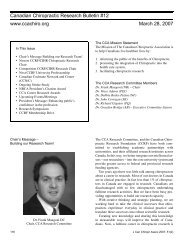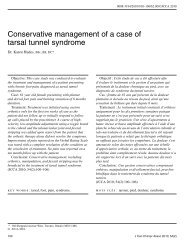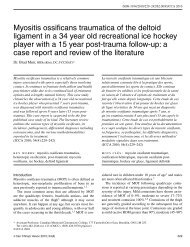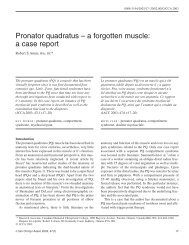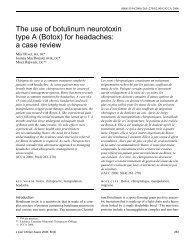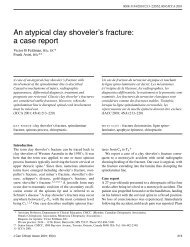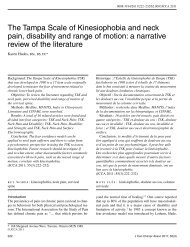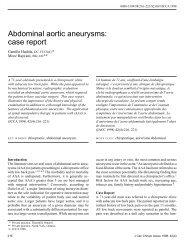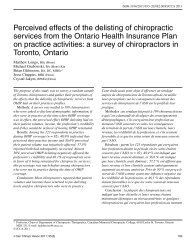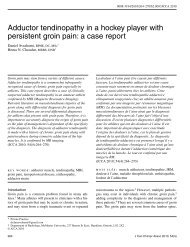View of the 50-year-old, Linear-No-Threshold Radiation Risk Model
View of the 50-year-old, Linear-No-Threshold Radiation Risk Model
View of the 50-year-old, Linear-No-Threshold Radiation Risk Model
- No tags were found...
You also want an ePaper? Increase the reach of your titles
YUMPU automatically turns print PDFs into web optimized ePapers that Google loves.
CommentaryA Rebuttal to Chiropractic Radiologists’ <strong>View</strong> <strong>of</strong> <strong>the</strong> <strong>50</strong>-<strong>year</strong>-<strong>old</strong>,<strong>Linear</strong>-<strong>No</strong>-Thresh<strong>old</strong> <strong>Radiation</strong> <strong>Risk</strong> <strong>Model</strong>Paul A Oakley, MSc, DCDonald D Harrison, PhD, DC, MSEDeed E Harrison, DCJason W Haas, DCThis discussion is in response to a letter-to-<strong>the</strong> editor in<strong>the</strong> form <strong>of</strong> a ‘Commentary’ by Bussieres, Ammendolia,Peterson, and Taylor 1 concerning our original commentary:‘On “phantom risks” associated with diagnosticionizing radiation: evidence in support <strong>of</strong> revising radiographystandards and regulations in chiropractic, 2 publishedin <strong>the</strong> December 2005 issue <strong>of</strong> this journal.Bussieres et al. 1 have expressed that our original commentarylacked credibility, while <strong>the</strong>y claimed that: 1) wehave a vested financial interest in promoting routine andfollow-up x-rays; 2) we provided a biased and unscientificevaluation <strong>of</strong> <strong>the</strong> evidence; 3) <strong>the</strong>re is “no convincingevidence that <strong>the</strong> use <strong>of</strong> radiography for spinal biomechanicalassessment (o<strong>the</strong>r than for scoliosis) is <strong>of</strong> any<strong>the</strong>rapeutic value”; and 4) ‘unnecessary’ x-rays are associatedwith high health care costs.Ad Hominem AttacksFirst, we will address <strong>the</strong>ir 1 “Ad Hominem” attacks onus. They referred to our paper as “self serving”, “pr<strong>of</strong>essionallyirresponsible”, and having a “vested financial interest”.An Ad Hominem attack has no place in ascientific debate. In fact, <strong>the</strong> Ad Hominem attack is one<strong>of</strong> <strong>the</strong> fallacies in scientific debates; instead <strong>of</strong> critiquing<strong>the</strong> science, attack <strong>the</strong> character <strong>of</strong> <strong>the</strong> individual. 3 Accordingto Stein, 3 when an individual resorts to an AdHominem attack, <strong>the</strong>y have lost credibility. <strong>No</strong>rmally, wewould ignore such insults, however, we note only two <strong>of</strong><strong>the</strong> four authors (Harrisons) have any financial gain fromCBP technique (by seminar attendance) – but how dodoctors, in different States/Provinces/Countries, x-raying<strong>the</strong>ir own patients, transcribe <strong>the</strong> knowledge gained aboutspinal health into a financial benefit for any <strong>of</strong> our authors?Biased and Unscientific Evaluation <strong>of</strong> <strong>the</strong> EvidenceSecond, Bussieres et al. 1 claimed that we presented a biasedand unscientific evaluation <strong>of</strong> <strong>the</strong> evidence on cancerrisks from exposure to ionizing radiation. We believe,while being brief, we presented <strong>the</strong> facts. We presented areview <strong>of</strong> 7 studies <strong>of</strong> human exposures to low-level radiationthat resulted in health benefits for <strong>the</strong>se populations.2 So, in support <strong>of</strong> our previous article, we willexpand on our evaluation <strong>of</strong> <strong>the</strong> evidence. For our discussion,we direct <strong>the</strong> reader to Figure 1 as a visual representation<strong>of</strong> <strong>the</strong> <strong>Linear</strong>-<strong>No</strong>-Thresh<strong>old</strong> <strong>Model</strong> (LNT) and <strong>the</strong><strong>Radiation</strong> Hormesis <strong>Model</strong> <strong>of</strong> cancer risks from exposureto ionizing radiation.Figure 1 “<strong>Linear</strong>” indicates <strong>the</strong> LNT <strong>Model</strong>, which is a linearextrapolation from <strong>the</strong> high dose (dose-rate) <strong>of</strong> atomic bombsdropped on Japan, drawn linearly down to zero. This modelassumes that any exposure has a cancer risk, and <strong>the</strong> greater<strong>the</strong> exposure, <strong>the</strong> greater <strong>the</strong> cancer risk. “Hormesis” is <strong>the</strong>quadratic shaped curve (U-shaped curve), where betweenzero and <strong>the</strong> zero equivalent point (ZEP), <strong>the</strong>re is less risk <strong>of</strong>cancer or a ‘benefit’. However, doses greater than <strong>the</strong> ZEP(a thresh<strong>old</strong>) indicate a near linear increased risk <strong>of</strong> cancer withincreasing doses. (adapted from Luckey, 1991 and Hiserodt,2005). 4,5172 J Can Chiropr Assoc 2006; <strong>50</strong>(3)
PA Oakley, DD Harrison, DE Harrison, JW HaasControversy in <strong>the</strong> BEIR VII ConclusionsBussieres et al. 1 fall prey to a typical argument on cancerrisks by citing references that neglect Hormesis evidence.They 1 cited <strong>the</strong> 2005 BEIR report 6 and a few o<strong>the</strong>r referencesused in <strong>the</strong> BEIR report. 7–10 We had read parts <strong>of</strong><strong>the</strong> long BEIR report and noted that it <strong>of</strong>ten made itsclaims while assuming <strong>the</strong> LNT model. In fact, whatBussieres et al. 1 failed to mention is that, in 2005, Aurengoet al. 11 compared <strong>the</strong> Reports by <strong>the</strong> French Academy<strong>of</strong> Sciences and <strong>the</strong> French Academy <strong>of</strong> Medicine, both<strong>of</strong> which reached <strong>the</strong> same opposite conclusion to BEIRVII.Aurengo et al. 11 found that <strong>the</strong> BEIR report neglectedhormesis evidence and neglected negative analyses <strong>of</strong> <strong>the</strong>studies that were cited. Also we note that <strong>the</strong> BEIR Reporthas not been <strong>of</strong>ficially issued yet, (only a preliminarydraft on <strong>the</strong>ir web site) and is still subject to change.In contrast, <strong>the</strong> unanimous report by <strong>the</strong> French Academy<strong>of</strong> Sciences and National Academy <strong>of</strong> Medicine (2005)stated:“In conclusion, this report doubts <strong>the</strong> validity <strong>of</strong> using <strong>the</strong>LNT in <strong>the</strong> evaluation <strong>of</strong> <strong>the</strong> carcinogenic risk <strong>of</strong> low doses(
Commentaryer, Feinendegen 26 estimated that ROS causes about 0.1DSB per cell per day, whereas 100 mSv (10 rem) <strong>of</strong> radiationcauses about 4 DSB per cell. Using this information,a 100 mSv dose <strong>of</strong> radiation would increase <strong>the</strong>lifetime risk <strong>of</strong> cancer (28,000 days x 0.1 DSB/day) byonly about 0.14% (4/28,000), but <strong>the</strong> LNT model predicts7 times that much at 1%.2. Direct Experimental Challenges to <strong>the</strong> Basis for LNTA direct failure <strong>of</strong> <strong>the</strong> basis for <strong>the</strong> LNT model is derivedfrom microarray studies, which determine what genes areup-regulated and what genes are down-regulated by radiation.It was discovered that generally different sets <strong>of</strong>genes are affected by low-level radiation as compared tohigh-level doses. In 2003, Yin et al. 28 used doses <strong>of</strong> 0.1Sv and 2.0 Sv applied to mouse brain. The 0.1 Sv doseinduced expression <strong>of</strong> protective and repair genes, while<strong>the</strong> 2.0 Sv dose did not.A similar study on human fibroblast cells was conductedin 2002 by G<strong>old</strong>er-<strong>No</strong>voselsky et al. 29 Using doses <strong>of</strong>0.02 Sv and 0.5 Sv, <strong>the</strong>y discovered that <strong>the</strong> 0.02 Sv doseinduced stress response genes, while <strong>the</strong> 0.5 Sv dose didnot. Several o<strong>the</strong>r microarray studies have demonstratedthat high radiation doses, which serve as <strong>the</strong> “calibration”for LNT, are not equivalent to adding an accumulation <strong>of</strong>low radiation doses. 30In fact, in 2001, Tanooka 31 studied tumor induction byirradiating <strong>the</strong> skin <strong>of</strong> mice throughout <strong>the</strong>ir lifetimes.For irradiation rates <strong>of</strong> 1.5 Gy/week, 2.2 Gy/week, and 3Gy/week, <strong>the</strong> percentage <strong>of</strong> mice that developed tumorswas 0%, 35%, and 100%, respectively. This 31 data demonstrateda clear thresh<strong>old</strong> response directly in conflictwith predictions <strong>of</strong> <strong>the</strong> LNT model.3. Effects <strong>of</strong> Low-Level <strong>Radiation</strong> onBiological Defense MechanismsIn 1994, <strong>the</strong> United Nations Scientific Committee on Effects<strong>of</strong> Atomic <strong>Radiation</strong> (UNSCEAR) report 32 defined“adaptive response” as a type <strong>of</strong> biological defense mechanismthat is characterized by sequent protection tostresses after an initial exposure <strong>of</strong> a stress (like radiation)to a cell. For radiation experiments, this is studiedby exposing cells to low-doses to prime <strong>the</strong> adaptive responseand <strong>the</strong>n later exposing it to a high radiation“challenge dose” to see what happens. There have beenseveral experiments in this topic, 33–42 and we report onjust a few <strong>of</strong> <strong>the</strong>se. 33–35In 1990, Cai and Liu 33 exposed mouse cells in 2 differentways: (1) a high dose <strong>of</strong> 65 cGy (65 rad), and (2) alow-dose <strong>of</strong> 0.2 cGy before <strong>the</strong> high-dose <strong>of</strong> 65 cGy. Thenumber <strong>of</strong> chromosome aberrations reduced in <strong>the</strong> secondgroup compared to <strong>the</strong> first group was 38% bonemarrow cell aberrations reduced to 19.5% and 12.6%spermatocyte aberrations reduced to 8.4 %.In 1992, Shadley and Dai 34 irradiated human lymphocytecells, some with high doses and some with alow-dose a few hours before a high-dose. The number <strong>of</strong>chromosome aberrations caused by a high-dose was substantiallyreduced when a preliminary low-dose was givenfirst.In 2001, Ghiassi-nejad et al. 35 studied this effect in humans.In Iran, residents <strong>of</strong> a high background radiationarea (1 cGy/<strong>year</strong>) were compared to residents in a normalbackground radiation area (0.1 cGy/yea). When lymphocytes,taken from <strong>the</strong>se groups, were exposed to 1.5Gy (1<strong>50</strong> rad), <strong>the</strong> percentages <strong>of</strong> aberrations were 0.098for <strong>the</strong> high background area versus 0.176 (about double)for <strong>the</strong> low background area. The radiation in <strong>the</strong> highbackground area protected its residents from <strong>the</strong> 1.5 Gydose.4. Stimulation <strong>of</strong> <strong>the</strong> Immune SystemThe effects <strong>of</strong> low-level radiation on <strong>the</strong> immune systemare important since <strong>the</strong> immune system is responsible fordestroying cells with DNA damage. Low doses <strong>of</strong> radiationexposure cause stimulation <strong>of</strong> <strong>the</strong> immune systemwhile high doses reduce immune activity. 43–45Contrary to expectations from <strong>the</strong> basic assumption <strong>of</strong><strong>the</strong> LNT model (cancer risks depends only on total dose),effects on <strong>the</strong> immune system are quite different for <strong>the</strong>same total dose given at a low dose rate (summation <strong>of</strong>several small doses) versus one high dose rate, i.e., at lowdose rates <strong>the</strong> immune system is stimulated, while at highdoses, cancers are caused. 46–<strong>50</strong>5. Cancer <strong>Risk</strong>s vs Dose (Animal Experiments)To test <strong>the</strong> validity <strong>of</strong> <strong>the</strong> LNT model, <strong>the</strong>re have beennumerous direct experiments <strong>of</strong> cancer risk versus dose,with animals exposed to various radiation doses. In 1979,Ullrich and Storer 51 reported that exposed animals livedup to 40% longer than controls. In a series <strong>of</strong> animalstudies in <strong>the</strong> 19<strong>50</strong>s and 1960s, review articles by Finkel174 J Can Chiropr Assoc 2006; <strong>50</strong>(3)
PA Oakley, DD Harrison, DE Harrison, JW Haasand Biskis 52–54 reported, with high statistical significance,that <strong>the</strong> LNT model over-estimated <strong>the</strong> cancerrisks from low-level radiation exposures and <strong>the</strong>y reporteda thresh<strong>old</strong> not a linear response.In a 2001 review <strong>of</strong> over 100 animal radiation experiments,Duport 55 reported on studies involving over85,000 exposed animals and 45,000 controls, with a total<strong>of</strong> 60,000 cancers in exposed animals and 12,000 cancersin control animals. In cases where cancers were observedin controls receiving low doses, ei<strong>the</strong>r no effect or an apparentreduction in cancer risk was observed in 40% <strong>of</strong><strong>the</strong> data sets for neutron exposure, <strong>50</strong>% <strong>of</strong> <strong>the</strong> data setsfor x-ray exposure, 53% <strong>of</strong> <strong>the</strong> data sets for gamma raysexposure, and 61% <strong>of</strong> <strong>the</strong> data sets for alpha particles exposure.6. Cancer <strong>Risk</strong>s vs Dose (Human Experiments):A. Critique <strong>of</strong> Data Frequently Cited in Support <strong>of</strong> LNTThe principle data cited and used to support <strong>the</strong> LNTmodel are those for solid tumors (all cancers exceptleukemia) in <strong>the</strong> survivors <strong>of</strong> <strong>the</strong> Japanese atomic bombexplosions. Pierce’s 1996 paper 56 reported data from1945–1990. By ignoring <strong>the</strong> error bars, supporters <strong>of</strong> <strong>the</strong>LNT model claim that <strong>the</strong> data suggests an approximatelinear relationship with intercept near zero. But <strong>the</strong>re isno data that gives statistical significant indication <strong>of</strong> excesscancers for radiation doses below 25 cSv. 57 Leukemiadata from Japanese A-bomb survivors stronglysuggest a thresh<strong>old</strong> above 20 cSv and <strong>the</strong> contradiction to<strong>the</strong> LNT model is recognized by <strong>the</strong> author. 57 In 1998,Cohen 58 used <strong>the</strong> three lowest dose points in <strong>the</strong> Japanesedata (0-20 cSv) to show that <strong>the</strong> slope <strong>of</strong> <strong>the</strong> dose-responsecurve has a 20% probability <strong>of</strong> being negative(i.e., Hormesis = risk decreasing with increasing dose).The next <strong>of</strong>ten cited evidence, by supporters <strong>of</strong> <strong>the</strong>LNT model, is <strong>the</strong> International Association for Researchon Cancer (IARC) studies on monitored radiation workers.In 1995, Cardis et al. 59 reported on 95,673 monitoredradiation workers in 3 countries and in a follow-up studyby <strong>the</strong> same authors in 2005, 60 <strong>the</strong>y reported on 407,000monitored workers in 154 facilities in 15 countries. In <strong>the</strong>first study, for all cancers except leukemia (<strong>the</strong>re were3,830 deaths, but no excess over <strong>the</strong> number expectedfrom <strong>the</strong> general population), <strong>the</strong> risks were reported as –0.07/Sv with 90% confidence limits <strong>of</strong> (–04,+0.3), i.e.,<strong>the</strong>re is NO support for LNT from this data! However, forleukemia (146 deaths), <strong>the</strong>y reported a positive correlation,but <strong>the</strong>ir data had no indication <strong>of</strong> any excess cancers(risks) below 40 cSv. Most importantly, <strong>the</strong>seauthors discarded 3/7 <strong>of</strong> <strong>the</strong>ir data points when observed/expected was less than unity. In fact, Cohen 23 noted that(1) no information on such confounding factors as smokingwas given, (2) if data from just one <strong>of</strong> <strong>the</strong> 15 countrieswas eliminated (Canada), <strong>the</strong> appearing excess is nolonger statistically different from zero, (3) <strong>the</strong> authors didnot consider non-occupational exposure (natural backgroundradiation) and if <strong>the</strong>y had, <strong>the</strong>y would have noticedthat <strong>the</strong>ir excess “signal” was much smaller than <strong>the</strong>“noise” from background radiation.Often critics <strong>of</strong> <strong>Radiation</strong> Hormesis use <strong>the</strong> “HealthyWorker effect” to discredit what is found. When studyingmortality rates for employed workers compared to <strong>the</strong>general population, it is found that workers have lowermortality rates. In Sweden in 1999, Gridley 61 compared545,000 employed women to 1,600,000 unemployedwomen. He reported that <strong>the</strong> cancer incidence rate wasslightly higher for employed women (1.05 ± 0.01). Thiseliminated <strong>the</strong> claims <strong>of</strong> <strong>the</strong> “Healthy Worker effect”. Foran example <strong>of</strong> improper use <strong>of</strong> this effect, in 2005Rogel 62 studied 22,000 monitored workers in <strong>the</strong> Frenchnuclear power industry. The cancer mortality rate wasonly 58% <strong>of</strong> <strong>the</strong> general French population. Instead <strong>of</strong>concluding a Hormesis effect, Rogel claimed that thislarge difference was due to <strong>the</strong> “healthy worker effect”. 62B. Data Contradictory to LNTThere is much data contradictory to <strong>the</strong> LNT model.There are multiple human studies which show a radiationHormesis effect. 16,22,64–72For breast cancer in Canadian women, Miller 63 reporteda decrease risk with increasing dose up to 25 cSV.Howe 64 (for lung cancer in Canadian women) andDavis 65 (for 10,000 people in Massachusetts) separatelyreported a decrease in cancers in <strong>the</strong> low-dose region upto 100 cSv. There is a difference between lung cancerrates in Japanese A-bomb survivors and <strong>the</strong> data fromHowe and Davis: <strong>the</strong> Japanese survivors show a muchhigher risk at all doses. This indicates that one must notaccept A-bomb survivor data (one large dose) to predictrisks from low-dose rates where low-level doses aresummed. It is known that risks from summing low doses(such as spinal radiography use in chiropractic) does notJ Can Chiropr Assoc 2006; <strong>50</strong>(3) 175
Commentaryequal <strong>the</strong> risks from one large dose (Tubiana). 30Kostyuchenko 66 reported on a follow-up <strong>of</strong> 7,852 villagersexposed in <strong>the</strong> 1957 radioactive storage facility explosionin Russia. The cancer mortality rate was muchlower in <strong>the</strong>se villagers than in unexposed villagers in <strong>the</strong>same area supporting a hormetic effect. However, <strong>the</strong> exposure<strong>of</strong> <strong>the</strong> workers directly at <strong>the</strong> facility was quitehigh in one dose and <strong>the</strong>se workers were found to have anincrease in cancers indicating a dose thresh<strong>old</strong> for increasecancers (Koshurnikova 2002). 67In 1997, Sakamoto 68 reported on radiation treatmentsin non-Hodgkin’s lymphoma. Patient groups were randomlyseparated into radiation treatment and non-radiationtreatment. After 9 <strong>year</strong>s, <strong>50</strong>% <strong>of</strong> <strong>the</strong> control groupdied but only 16% <strong>of</strong> <strong>the</strong> irradiated group died.The conclusion from Cohen’s outline 23 is that <strong>the</strong> LNT<strong>the</strong>ory fails badly in <strong>the</strong> low dose region. It grossly overestimates<strong>the</strong> cancer risks from low-level radiation. Thecancer risk from <strong>the</strong> vast majority <strong>of</strong> normally encounteredradiation exposures (background radiation, medicalx-rays, etc.) is much lower than estimates given by supporters<strong>of</strong> <strong>the</strong> LNT model, and it may well be zero oreven negative.Critique <strong>of</strong> Bussieres et al. 1 Cancer <strong>Risk</strong> ReferencesAs previously discussed, Aurengo 11 reported on twogroups who came to <strong>the</strong> opposite conclusions comparedto <strong>the</strong> 2005 BEIR report. 6In <strong>the</strong>ir risks argument, Bussieres et al. 1 passionatelypresent (<strong>the</strong>ir table 1) <strong>the</strong> number <strong>of</strong> estimated cancerdeaths per <strong>year</strong> as calculated from known x-ray usage in<strong>the</strong> Berrington de Gonzalez study. 8 This study 8 reliedsolely on <strong>the</strong> LNT model and has been critcized by manyfor several reasons. First, as several critics noted 73–76 andfor which <strong>the</strong> authors 8 admitted in <strong>the</strong>ir reply, 77 <strong>the</strong>yfailed to weigh <strong>the</strong> benefits <strong>of</strong> diagnostic x-rays in <strong>the</strong>irstudy, which only guarantees an overestimate <strong>of</strong> deathcalculations. Ano<strong>the</strong>r criticism was <strong>the</strong>ir assumption <strong>of</strong><strong>the</strong> LNT to make <strong>the</strong>ir cancer death estimations. Tubianaet al. 74 pointed out <strong>the</strong> “speculative nature” <strong>of</strong> <strong>the</strong> LNThypo<strong>the</strong>sis, and along with Simmons, 78 noted that <strong>the</strong>LNT is only compatible with exposures greater than200mSv ( significantly more radiation than any medicalx-rays).Ano<strong>the</strong>r criticism is that <strong>the</strong> Japanese survival data hassignificant limitations to extrapolate its use for x-ray riskestimates from g rays. The Japanese exposure was a onetime high dose, which is entirely different from accumulatedsmall dose rates. Herzog and Rieger 73 note that thisdata will overestimate cancer risk because <strong>the</strong> Japanesewere exposed to g rays from bombs, a different energyspectrum than x-rays, but also <strong>the</strong> additional exposures <strong>of</strong>b radiation, radionuclides emitting b, and high-energy aradiation from contaminated water, food, and dust.Yet ano<strong>the</strong>r criticism <strong>of</strong> <strong>the</strong> study was that <strong>the</strong>re was nomention <strong>of</strong> <strong>the</strong> complexity and effectiveness <strong>of</strong> <strong>the</strong> humancell’s defenses against ionizing radiation. Tubiana etal. 74 noted <strong>the</strong>re are hundreds <strong>of</strong> enzymes devoted to protecta cell from <strong>the</strong>se effects and that “<strong>the</strong>re is no singledefense mechanism but a variety,… an adaptive effect existsand a hormetic effect has even been seen in more thanhalf <strong>of</strong> experimental studies after low or moderate doses.”79–80 “Extrapolation from high doses to low doseswith LNT is unlikely to be able to assess <strong>the</strong> risks accurately.”74For Bussieres et al. 1 to use this study as ‘evidence’ forrationale for x-ray guidelines is dubious. In fact, withoutmentioning <strong>the</strong> scientific peer concerns surrounding <strong>the</strong>study, 73–76,78 (it is readily observed on pub-med that anumber <strong>of</strong> letters to <strong>the</strong> editor were published) we canonly conclude that <strong>the</strong>y 1 are <strong>the</strong> ones presenting a ‘biased’evaluation <strong>of</strong> <strong>the</strong> evidence.<strong>No</strong> Convincing Evidence for <strong>the</strong> Use <strong>of</strong>Radiography for Spinal AssessmentNext, we arrive at Bussieres et al. 1 third complaint aboutour original article. Using 3 references, (Ammendolia etal., 81 Mootz et al., 82 Haas et al. 83 ) Bussieres et al. 1 state x-rays are not useful due to lack <strong>of</strong> clinical relevance. TheAmmendolia article 81 is a questionnaire study with a focusedgroup interview about clinicians’ opinions andpractices regarding acute low back pain only. This paperdisregarded an entire body <strong>of</strong> evidence in opposition to<strong>the</strong> papers’ conclusions that was not addressed. 84Fur<strong>the</strong>r, as in <strong>the</strong>ir commentary at hand, 1 medical‘diagnostic red flag only’ references are used for achiropractic argument against x-ray usage. That is, chiropracticdoctors differ fundamentally in assessment,diagnosis, and treatment than <strong>the</strong>ir medical counterparts.Therefore, Medical references apply to <strong>the</strong> pr<strong>of</strong>ession <strong>of</strong>drugs and surgery, NOT chiropractic, which uses physicalforces applied to spines. <strong>No</strong>t only is <strong>the</strong> spinal structure176 J Can Chiropr Assoc 2006; <strong>50</strong>(3)
PA Oakley, DD Harrison, DE Harrison, JW Haasintricately examined by chiropractors but as Mootz etal. 82 states: “identifying contraindications to ... manipulation,however, is a purpose that belongs only to practitioners<strong>of</strong> manual <strong>the</strong>rapies, especially DCs.”Bussieres et al. 1 commit a common error by citingHaas et al. 83 without acknowledging that this is <strong>the</strong> middlepaper <strong>of</strong> a 3-part debate. 85.86 The Haas reference 83 hasbeen clearly rebutted. 86The Mootz et al. 82 review is a decade <strong>old</strong>, and even<strong>the</strong>y stated “using plain film imaging, single studies resultin relatively insignificant radiation dosages and expense.”At that time, (1997) Mootz et al. 82 suggested thatchanges in patient misalignment had yet to be determinedto impact clinical progress. Despite even being arguableat that time, in <strong>the</strong> following decade, <strong>the</strong>re has been a variety<strong>of</strong> good quality, biomechanical and outcome studiesdefining this relationship published by <strong>the</strong> CBP group. 87–96 In fact, in <strong>the</strong> recent ICA X-ray Guidelines (PCCRP),<strong>the</strong>re are hundreds <strong>of</strong> Chiropractic outcome studies cited.97Fur<strong>the</strong>rmore, Bussieres et al. 1 failed to acknowledge<strong>the</strong> recent randomized trial by Khorshid et al. 98 where aclinically and statistically significant improvement in autisticchildren treated with upper cervical technique (usingx-rays) was found compared to those treated withstandard full spine technique (no x-rays).Previous authors have stated that guidelines for chiropracticclinicians’ and manual <strong>the</strong>rapists’ utilization <strong>of</strong>x-ray should be different from those <strong>of</strong> a medical practitionerwho does not use spinal adjustments/forces andrehabilitation procedures as treatment for spinal subluxations.99–101 In studies specifically considering <strong>the</strong> role <strong>of</strong>chiropractic treatment interventions, spinal radiographicviews indicate that between 66%–91% <strong>of</strong> patients canhave significant abnormalities affecting treatment: 102–10433% can have relative contraindications and 14% canhave absolute contraindications to certain types <strong>of</strong> chiropracticadjustment procedures. 104Radiography Is <strong>No</strong>t Cost EffectiveBussieres et al. 1 mention that patients receiving radiographyare more satisfied with care, but <strong>the</strong>n discard thisfinding in favor <strong>of</strong> a ‘cost reducing model <strong>of</strong> health care’.We feel it is important to present this information inproper context.For example, in a randomized trial comparing <strong>the</strong> intervention<strong>of</strong> lumbar radiography to no radiography inpatients with at least 6 weeks duration <strong>of</strong> low back pain,Kendrick et al. 105,106 found no differences in outcomesbetween <strong>the</strong> groups. Problematically, <strong>the</strong> interventionused for treatment did not specifically address any structuralspinal displacements as chiropractic clinicianswould readily apply. Importantly, patients receiving radiographywere more satisfied with <strong>the</strong> care <strong>the</strong>y received.105,106 Fur<strong>the</strong>rmore, patients allocated to apreference group, where <strong>the</strong> decision to receive lumbarradiography was made by <strong>the</strong>m, achieved clinically significantimproved outcomes compared to those randomizedto a non-radiography or a radiography group. 106Thus, undercutting patient choice by ‘red flag’ onlyguidelines, as Bussieres et al. 1 would have us do forchiropractic practice, limits a patient’s right to choose andmay impair or slow recovery. However, just as importantly,we caution Bussieres et al. 1 for applying results fromclinical studies with pharmacology and PT treatments toChiropractic situations where <strong>the</strong> treatments are vastlydifferent (physical forces applied to spinal structures).While cost-effectiveness analysis may favor limited x-ray utilization in a volume 3rd party payer scenariowhere maximization <strong>of</strong> pr<strong>of</strong>its is <strong>the</strong> goal, 107 in <strong>the</strong> individualpatient, case specific circumstances can lead to adifferent conclusion. It is our perspective that, in chiropracticclinical practice, <strong>the</strong> needs <strong>of</strong> <strong>the</strong> one outweigh<strong>the</strong> needs <strong>of</strong> <strong>the</strong> many or <strong>the</strong> managed care organization;our duty is to identify <strong>the</strong> spinal problem <strong>of</strong> <strong>the</strong> individualand develop solution strategies where possible.Lastly, <strong>the</strong>re is an expectation by <strong>the</strong> consumer to havea thorough spinal evaluation when seeing a DC for ahealth problem and this includes an x-ray evaluation foralignment <strong>of</strong> <strong>the</strong> spine and <strong>the</strong> state <strong>of</strong> health <strong>of</strong> <strong>the</strong>spine. 108ConclusionIn summary, Bussieres et al.’s 1 Ad Hominem attacks onus and <strong>the</strong>ir main arguments against routine use <strong>of</strong> radiographyin common practice, radiation risks, and lack <strong>of</strong>clinical usefulness are without scientific support. In fact,Luckey stated, “for every thousand cancer mortalitiespredicted by <strong>the</strong> linear models (LNT), <strong>the</strong>re will be athousand decreased cancer mortalities and ten thousandpersons with improved quality <strong>of</strong> life.” 4J Can Chiropr Assoc 2006; <strong>50</strong>(3) 177
CommentaryReferences1 Bussieres AE, Ammendolia C, Peterson C, Taylor JAM.Ionizing radiation exposure – more good than harm? Thepreponderance <strong>of</strong> evidence does not support abandoningcurrent standards and regulations. J Can Chiropr Assoc2006; <strong>50</strong>(2):103–106.2 Oakley PA, Harrison DD, Harrison DE, Haas JW. On“phantom risks” associated with diagnostic radiation:evidence in support <strong>of</strong> revising radiography standards andregulations in chiropractic. J Can Chiropr Assoc 2005;49(4):264–269.3 Stein F. Anatomy <strong>of</strong> Research in Allied Health. New York:John Wiley & Sons. 1976, pg 45.4 Luckey TD. <strong>Radiation</strong> hormesis. Boca Raton: CRC Press,Boston, 1991.5 Hiserodt E. Underexposed: What if radiation is actuallygood for you? Laissez Faire Books, Little Rock, Arkansas,2005.6 Committee to assess health risks from exposure to lowlevels <strong>of</strong> ionizing radiation. Health risks from exposure tolow levels <strong>of</strong> ionizing radiation: BEIR VII Phase 2.National Research Council. Washington DC: NationalAcademies Press, 2005.7 Evans JS, Wennberg JE, McNeil BJ. The influence <strong>of</strong>diagnostic radiography on <strong>the</strong> incidence <strong>of</strong> breast cancerand leukemia. N Engl J Med 1986; 315(13):810–5.8 Berrington de Gonzalez A, Darby S. <strong>Risk</strong>s <strong>of</strong> cancer fromdiagnostic x-rays: estimates for <strong>the</strong> UK and 14 o<strong>the</strong>rcountries. Lancet 2004; 363:345–51.9 Assesssment and management <strong>of</strong> cancer risks fromradiological and chemical hazards 1998 Health Canada,Atomic Energy Control Board ISBN: 0-662-82719-8.10 Shiralkar S, Rennie A, Snow M, Galland RB, Lewis MH,Gower-Thomas K. Doctors' knowledge <strong>of</strong> radiationexposure: questionnaire study. BMJ 2003; 327:371–72.11 Aurengo, A. et al. (2005) Dose-effect relationship andestimation <strong>of</strong> <strong>the</strong> carcinogenic effects <strong>of</strong> low dose ionizingradiation, Available at http://cnts.wpi.edu/rsh/docs/FrenchAcads-EN-FINAL.pdf12 Cohen BL, Lee IS. A catalog <strong>of</strong> risks. Health Physics 1979;36:707–722.13 Cohen B.L. Limitations and problems in deriving riskestimates for low-level radiation exposures. J Biol Med1981; 54:329–338.14 Cohen BL. Catalog <strong>of</strong> risks extended and updated. HealthPhysics 1991; 61(3):317–335.15 Cohen BL. Dose-response relationship for radiationcarcinogenesis in <strong>the</strong> low-dose region. Int Arch OccupEnviron Health 1994; 66:71–75.16 Cohen BL. Test <strong>of</strong> <strong>the</strong> linear-no thresh<strong>old</strong> <strong>the</strong>ory <strong>of</strong>radiation carcinogenesis for inhaled radon decay products.Health Phys 1995; 68:157–174.17 Cohen BL. How dangerous is low level radiation? <strong>Risk</strong>Anal 1995; 15:645–653.18 Cohen BL. Problems in <strong>the</strong> radon vs. lung cancer test <strong>of</strong> <strong>the</strong>linear no-thresh<strong>old</strong> <strong>the</strong>ory and a procedure for resolving<strong>the</strong>m. Health Phys 1997; 72:623–628.19 Cohen BL. Updates and extensions to tests <strong>of</strong> <strong>the</strong> linearno-thresh<strong>old</strong> <strong>the</strong>ory. Technology 2000; 7:657–672.20 Cohen BL. The cancer risk from low level radiation: areview <strong>of</strong> recent evidence. Med Sent 2000; 5:128–131.21 Cohen BL. Cancer risk from low-level radiation. Am JRadiol 2002; 179:1137–1143.22 Cohen BL. Test <strong>of</strong> <strong>the</strong> linear-no-thresh<strong>old</strong> <strong>the</strong>ory: rationalefor procedures. <strong>No</strong>nlinearity in Biology, Toxicology, andmedicine 2005; 3:261–82.23 Cohen BL. Outline <strong>of</strong> a <strong>Radiation</strong> Handbook. PrivateCommunication, June 2006.24 Pollycove M and Feinendagen L. Biologic responses to lowdoses <strong>of</strong> ionizing radiation: detriment vs hormesis; Part 1.J Nuclear Med 2001; 42:17N–27N.25 Kondo S. Health Effects <strong>of</strong> Low Level <strong>Radiation</strong>. Madison,WI; Medical Physics Publishing, 1993; pp 85–89.26 Feinendegen LE. Evidence for beneficial low levelradiation effects and radiation hormesis. Brit J Radiol2005; 78:3–7.27 Bonner WN. Phenomena leading to cell survival valueswhich deviate from linear-quadratic models. Mutation Res2004; 568:33–39.28 Yin, E. et al. Gene expression changes in mouse brain afterexposure to low-dose ionizing radiation, Int J Radiat Biol2005; 79:759–775.29 G<strong>old</strong>er-<strong>No</strong>voselsky, E., Ding, LH, Chen,F, and Chen,DJ.<strong>Radiation</strong> response in HSF cDNA microarray analysis,DOE Low dose radiation research program, Workshop III,U.S. Dept. <strong>of</strong> Energy, Washington, DC, 2002.30 Tubiana M, Aurengo A. Dose effect relationship andestimation <strong>of</strong> <strong>the</strong> carcinogenic effects <strong>of</strong> low doses <strong>of</strong>ionizing radiation. Int J Low Radiat 2005; 2:1–1931 Tanooka H. Thresh<strong>old</strong> dose-response in radiationcarcinogenesis: an approach from chronic beta-irradiationexperiments and a review <strong>of</strong> non-tumor doses. Int J RadiatBiol 2001; 77:541–551.32 UNSCEAR (United Nations Scientific Committee onEffects <strong>of</strong> Atomic <strong>Radiation</strong>). Report to <strong>the</strong> GeneralAssembly, Annex B: Adaptive Response. United Nations,New York, 1994.33 Cai L, Liu SZ. Induction <strong>of</strong> cytogenic adaptive response <strong>of</strong>somatic and germ cells in vivo and in vitro by low doseX-irradiation. Int J Radiat Biol 1990; 58:187–194.34 Shadley JD, Dai GQ. Cytogenic and survival adaptiveresponses in G-1 phase human lymphocytes. Mutat Res1992; 265:273–281.35 Ghiassi-nejad M, Mortazavi SMJ, Beitollahi M, Cameron,JR, et al. Very high background radiation areas <strong>of</strong> Ramsar,Iran: preliminary biological studies and possibleimplications. Health Phys 2002; 82:87–93.178 J Can Chiropr Assoc 2006; <strong>50</strong>(3)
PA Oakley, DD Harrison, DE Harrison, JW Haas36 Coleman, M.A. et al. Low dose irradiation alters <strong>the</strong>transcript pr<strong>of</strong>iles <strong>of</strong> human lymphoblastoid cells includinggenes associated with cytogenic radioadaptive response,Radiat Res 2005; 164:369–382.37 Kelsey KT, Memisoglu A, Frenkel A, and Liber HL.Human lymphocytes exposed to low doses <strong>of</strong> X-rays areless susceptible to radiation induced mutagenesis. MutatRes 1991; 263:197–201.38 Fritz-Niggli H and Schaeppi-Buechi C. Adaptive responseto dominant lethality <strong>of</strong> mature and immature oocytes <strong>of</strong> D.Melanogaster to low doses <strong>of</strong> ionizing radiation: effects inrepair-pr<strong>of</strong>icient and repair deficient strains. Int J RadiatBiol 1991; 59:175–184.39 Le XC, Xing JZ, Lee J, Leadon SA, Weinfeld M. Induciblerepair <strong>of</strong> thymine glycol detected by an ultrasensitive assayfor DNA damage. Science 1998; 280:1066–1069.40 Azzam EI, de Toledo SM, Raaphorst GP, Mitchel REJ.Low dose ionizing radiation decreases <strong>the</strong> frequency <strong>of</strong>neoplastic transformation to a level below spontaneous ratein C3H 10T1/2 cells. Radiat Res 1996; 146:369–373.41 Redpath JL, Antoniono RJ. Induction <strong>of</strong> a rapid responseagainst spontaneous neoplastic transformation in vitro bylow dose gamma radiation, Rad Res 1998; 149:517–520.42 Yukawa O et al. Induction <strong>of</strong> radical scavenging ability andsuppression <strong>of</strong> lipid peroxidation in rat liver microsomesfollowing whole body low dose X-irradiation. J Radiat Biol2005; 81:681–688.43 Liu SJ. Multilevel mechanisms <strong>of</strong> stimulatory effect <strong>of</strong> lowdose radiation on immunity. In: Sugahara T, Sagan LA,Aoyama T, ed. Low Dose Irradiation and BiologicalDefense Mechanisms. Amsterdam, Elsevier Science, 1992:pp 225–232.44 Makinodan T. Cellular and sub-cellular alteration inimmune cells induced by chronic intermittent exposure invivo to very low dose <strong>of</strong> ionizing radiation and itsameliorating effects on progression <strong>of</strong> autoimmune diseaseand mammary tumor growth. In: Sugahara T, Sagan LA,Aoyama T, ed. Low Dose Irradiation and BiologicalDefense Mechanisms, Amsterdam, Elsevier Science, 1992:pp. 233–237.45 Liu SZ. <strong>No</strong>n-linear dose-response relationship in <strong>the</strong>immune system following exposure to ionizing radiation:mechanisms and implications, <strong>No</strong>nlinearity in Biology,Toxicology, and Medicine 2003; 1:71–92.46 Ina Y, Sakai K. Activation <strong>of</strong> immunological network bychronic low dose rate irradiation in wild type mousestrains: analysis <strong>of</strong> immune cell populations and surfacemolecules, Int J Radiat Biol 2005; 81:721–729.47 Ina Y et al. Suppression <strong>of</strong> thymic lymphoma inductionby life-long low dose rate irradiation accompanied byimmune activation <strong>of</strong> C57BL/6 mice, Radiat Res 2005;163:153–158.48 Sakamoto K, Myogin M, Hosoi Y, et al. Fundamental andclinical studied on cancer control with total and upper halfbody irradiation. J Jpn Soc Ther Radiol Oncol 1997;9:161–175.49 Hashimoto S, Shirato H, Hosokawa M, et al. Thesuppression <strong>of</strong> metastases and <strong>the</strong> change in host immuneresponse after low-dose total body irradiation in tumorbearing rats. Radiat Res 1999; 151:717–724.<strong>50</strong> Makinodan T, James SJ. T cell potentiation by low doseionizing radiation: possible mechanisms. Health Phys1990; 59:29–3451 Ullrich RL, Storer JB. Influence <strong>of</strong> gamma radiation on <strong>the</strong>development <strong>of</strong> neoplastic diseases in mice: II solidtumors. Radiat Res 1979; 80:317–324.52 Finkel MP, Biskis BO. Toxicity <strong>of</strong> Plutonium in mice.Health Phys1962; 8:565–579.53 Finkel MP, Biskis BO. Prog Exp Tumor Res 1968; 10:72ff.54 Finkel, MP, Biskis BO. Pathological consequences <strong>of</strong>radiostrontium administered to fetal and infant dogs.<strong>Radiation</strong> biology <strong>of</strong> <strong>the</strong> fetal and juvenile mammal, AECSymposium Series, vol. 17, Proceedings <strong>of</strong> <strong>the</strong> 9th HanfordBiology Symposium, 1969: pp. 543–565.55 Duport P. A data base <strong>of</strong> cancer induction by low-doseradiation in mammals: overview and initial observations,Second Conference <strong>of</strong> <strong>the</strong> World Council <strong>of</strong> NuclearWorkers (WUNOC), Dublin, 2001.56 Pierce DA, Shimizu Y, Preston DL, Vaeth M, Mabuchi K.Studies <strong>of</strong> <strong>the</strong> mortality <strong>of</strong> atomic bomb survivors, Report12, Part 1, Cancer: 19<strong>50</strong>–1990. Radiat Res 1996; 146:1–27.57 Heidenreich WF, Paretzke HG, Jacob B. <strong>No</strong> evidence forincreased tumor risk below 200 mSv in <strong>the</strong> atomic bombsurvivor data. Radiat Envoron Biophys 1997; 36:205–207.58 Cohen BL. The cancer risk from low level radiation. RadiatRes 1998; 149:525–526.59 Cardis E, et al. Effects <strong>of</strong> low dose and low dose rates <strong>of</strong>external ionizing radiation: Cancer mortality amongnuclear industry workers in three countries. Radiat Res1995; 142:117–132.60 Cardis E, et al. <strong>Risk</strong> <strong>of</strong> cancer after low doses <strong>of</strong> ionizingradiation: retrospective cohort study in 15 countries. BritMed J 2005; 331:77–90.61 Gridley G, et al. Is <strong>the</strong>re a healthy worker effect for cancerincidence among women in Sweden? Am J Ind Med 1999;36:193–199.62 Rogel A et al. Mortality <strong>of</strong> workers exposed to ionizingradiation at <strong>the</strong> French National Electricity company. Am JInd Med 2005; 47:72–82.63 Miller RC, Randers-Pehrson G, Geard CR, Hall EJ,Brenner, DJ. The oncogenic transforming potential <strong>of</strong> <strong>the</strong>passage <strong>of</strong> single alpha particles through mammalian cellnuclei. Proc Natl Acad Sci 1999; 96:19–22.J Can Chiropr Assoc 2006; <strong>50</strong>(3) 179
Commentary64 Howe GR. Lung cancer mortality between 19<strong>50</strong> and 1987after exposure to fractionated moderate dose rate ionizingradiation in <strong>the</strong> Canadian fluoroscopy cohort study and acomparison with lung cancer mortality in <strong>the</strong> atomic bombsurvivors study. Radiat Res 1995; 142:295–304.65 Davis HG, Boice JD, Hrubec Z, Monson RR. Cancermortality in a radiation-exposed cohort <strong>of</strong> Massachusettstuberculosis patients. Cancer Res 1989; 49:6130–6136.66 Kostyuchenko VA, Krestina LY. Long term irradiationeffects in <strong>the</strong> population evacuated from <strong>the</strong> East-Uralsradioactive trace area. The Science <strong>of</strong> <strong>the</strong> TotalEnvironment 1994; 142:119–125.67 Koshurnikova NA, et al. Studies <strong>of</strong> <strong>the</strong> Mayak nuclearworkers: health effects, Radiat Environ Biophys 2002;41:29–31.68 Sakamoto K, Myogin M, Hosoi Y; et al. Fundamental andclinical studied on cancer control with total and upper halfbody irradiation. J Jpn Soc Ther Radiol Oncol 1997;9:161–17569 Chen, WL et al. Is chronic radiation an effectiveprophylaxis against cancer?, J. Am. Physicians andSurgeons 2004; 9:6–10.70 Gilbert ES, Petersen GR, Buchanan JA. Mortality <strong>of</strong>workers at <strong>the</strong> Hanford site: 1945–1981. Health Phys 1989;56:11–25.71 Tokarskaya ZB, Okladlnikova ND, Belyaeva ZD, DrozhkoEG. Multifactorial analysis <strong>of</strong> lung cancer dose-responserelationships for workers at <strong>the</strong> Mayak Nuclear Enterprise.Health Phys 1997; 73:899–905.72 Voelz GL, Wilkinson CS, Acquavelle JF. An update <strong>of</strong>epidemiologic studies <strong>of</strong> plutonium workers. Supplement 1to Health Phys 1983; 44:493–<strong>50</strong>3.73 Herzog P, Rieger CT. <strong>Risk</strong> <strong>of</strong> cancer from diagnostic x-rays[Commentary]. Lancet 2004; 363:340–341.74 Tubiana M, Aurengo A, Masse R, Valleron AJ. <strong>Risk</strong> <strong>of</strong>cancer from diagnostic x-rays [Letter to Editor]. Lancet2004; 363:1908.75 Nagataki S. <strong>Risk</strong> <strong>of</strong> cancer from diagnostic x-rays [Letterto Editor]. Lancet 2004; 363:1909.76 Debnath D. <strong>Risk</strong> <strong>of</strong> cancer from diagnostic x-rays [Letterto Editor]. Lancet 2004; 363:1909.77 Berrington de Gonzalez A, Darby S. <strong>Risk</strong> <strong>of</strong> cancer fromdiagnostic x-rays [Author's Reply]. Lancet 2004;363(1910).78 Simmons JA. <strong>Risk</strong> <strong>of</strong> cancer from diagnostic x-rays [Letterto Editor]. Lancet 2004; 363:1908–1909.79 Duport P. A data base <strong>of</strong> cancer inductionby low-doseradiation in mammals: overviews and initial observations.Int J Low <strong>Radiation</strong> 2003; 1:120–131.80 Calabrese EJ, Baldwin LA. Toxicology rethinks its centralbelief. Nature 2003; 421:691–692.81 Ammendolia C, Bombardier C, Hogg-Johnson S, et al.<strong>View</strong>s on radiagraphy use for patients with acute low backpain among chiropractors in an Ontario community. JManipulative Physiol Ther 2002; 25:511–520.82 Mootz RD, H<strong>of</strong>fman LE, Hansen DT. Optimizing clinicaluse <strong>of</strong> radiography and miimizing radiation exposure inchiropractic practice. Top Clin Chiro 1997; 4(1):34–44.83 Haas M, Taylor JAM, Gillette RG. The routine use <strong>of</strong>radiographic spinal displacement analysis: a dissent.J Manipulative Physiol Ther 1999; 22(4):254–259.84 Hansen D, Belmont L, Fairbanks V, et al. <strong>View</strong>s onradiography use for patients with acute low back painamong chiropractors in an Ontario community [Letter toEditor]. J Manipulative Physiol Ther 2004; 27(3):218–219.85 Harrison DE, Harrison DD, Troyanovich SJ. Reliability <strong>of</strong>Spinal Displacement Analysis on Plane X-rays: A Review<strong>of</strong> Commonly Accepted Facts and Fallacies withImplications for Chiropractic Education and Technique.J Manipulative Physiol Ther 1998; 21(4):252–66.86 Harrison DE, Harrison DD, Troyanovich SJ, Harmon S.A normal spinal position: It's time to accept <strong>the</strong> evidence.J Manipulative Physiol Ther 2000; 23(9):623–644.87 Harrison DD, Cailliet R, Janik TJ, et al. Elliptical modeling<strong>of</strong> <strong>the</strong> sagittal lumbar lordosis and segmental rotationangles as a method to discriminate between normal and lowback pain subjects. J Spinal Disord 1998; 11(5):430–439.88 McAviney J, Schulz D, Bock R, Harrison DE, Holland B.Determining <strong>the</strong> relationship between cervical lordosis andneck complaints. J Manipulative Physiol Ther 2005;28(3):187–193.89 Harrison DD, Harrison DE, Janik TJ, et al. <strong>Model</strong>ing <strong>of</strong> <strong>the</strong>sagittal cervical spine as a method to discriminate hypolordosis:results <strong>of</strong> elliptical and circular modeling in 72asymptomatic subjects, 52 acute neck pain subjects, and 70chronic neck pain subjects. Spine 2004; 29(22):2485–2492.90 Harrison DE, Jones EW, Janik TJ, Harrison DD. Evaluation<strong>of</strong> axial and flexural stresses in <strong>the</strong> vertebral body cortexand trabecular bone in lordosis and two sagittal cervicaltranslation configurations with an elliptical shell model.J Manipulative Physiol Ther 2002; 26(6):391–401.91 Harrison DE, Harrison DD, Janik TJ, et al. Comparison <strong>of</strong>axial flexural stresses in lordosis and three buckledconfigurations <strong>of</strong> <strong>the</strong> cervical spine. Clinical Biomech2001; 16:276–284.92 Harrison DE, Cailliet R, Harrison DD, Janik TJ, Holland B.A new 3-point bending traction method for restoringcervical lordosis and cervical manipulation: Anonrandomized clinical controlled trial. Arch Phys MedRehab 2002; 83(4):447–453.93 Harrison DE, Cailliet R, Harrison DD, Janik TJ, Holland B.Changes in sagittal lumbar configurations with a newmethod <strong>of</strong> extension traction: <strong>No</strong>nrandomized clinicalcontrolled trial. Arch Phys Med Rehab 2002;83(11):1585–1591.180 J Can Chiropr Assoc 2006; <strong>50</strong>(3)
PA Oakley, DD Harrison, DE Harrison, JW Haas94 Harrison DE, Cailliet R, Betz J, et al. Conservativemethods for reducing lateral translation postures <strong>of</strong> <strong>the</strong>head: A non-randomized clinical control trial. J RehabilRes Dev 2004; 41(4):631–639.95 Harrison DE, Harrison DD, Betz J, et al. Increasing <strong>the</strong>cervical lordosis with seated combined extensioncompressionand transverse load cervical traction withcervical manipulation: <strong>No</strong>nrandomized clinical controltrial. J Manipulative Physiol Ther 2003; 26(3):139–151.96 Harrison DE, Cailliet R, Betz J, et al. A non-randomizedclinical control trial <strong>of</strong> Harrison mirror image methods forcorrecting trunk list (lateral translations <strong>of</strong> <strong>the</strong> thoraciccage) in patients with chronic low back pain. Euro Spine J2005; 14(2):155–162.97 Practicing Chiropractors’ Committee on RadiologicalProtocols (PCCRP). Practicing Chiropractors’ Guidelinesfor <strong>the</strong> Utilization <strong>of</strong> Plain Film X-Ray Imaging for<strong>the</strong> Biomechanical Assessment, Characterization, andQuantification <strong>of</strong> Spinal Subluxation in ChiropracticClinical Practice. Arlington, VA: InternationalChiropractic Association, July 2006.98 Khorshid KA, Sweat RW, Zemba DA, Zemba BN.Clinical efficacy <strong>of</strong> upper cervical versus full spinechiropractic care on children with autism: a randomizedclinical trial.J Vertebral Subluxation Res 2006; March 9:1–7.99 Plaugher, G. The Role <strong>of</strong> Plain Film Radiography inChiropractic Clinical Practice. Chiropractic J <strong>of</strong> Australia1992; 22(4):153–61.100 Sweat RW, Sweat MH. Guidelines for pre-and postradiographsfor care documentation. Todays Chiropr1995; 24:2.101 Jean-Yves Maigne. Is <strong>the</strong>re a need for routine X-rays priorto manipulative <strong>the</strong>rapy? Recommendations <strong>of</strong> <strong>the</strong>SOFMMOO French Society <strong>of</strong> Orthopaedic andOsteopathic Manual Medicine. www.s<strong>of</strong>mmoo.com/english_section/recommendations/radio.htm. AccessedMay 29th, 2006.102 Bull PW. Relative and absolute contraindications to spinalmanipulative <strong>the</strong>rapy found on spinal x-rays. Proceedings<strong>of</strong> <strong>the</strong> World Federation <strong>of</strong> Chiropractic 7th BiennialCongress; Orlando, FL, May 2003, page 376.103 Pryor M, McCoy M. Radiographic findings that may altertreatment identified on radiographs <strong>of</strong> patients receivingchiropractic care in a teaching clinic. J ChiropracticEducation 2006; 20(1):93–94.104 Beck RW, Holt KR, Fox MA, Hurtgen-Grace KL.Radiographic Anomalies That May Alter ChiropracticIntervention Strategies Found in a New ZealandPopulation. J Manipulative Physiol Ther 2004;27(9):554–559).105 Kendrick D, Fielding K, Bentley E, Kerslake R, Miller P,Pringle M. Radiography <strong>of</strong> <strong>the</strong> lumbar spine in primarycare patients with low back pain: randomized controlledtrial. BMJ. 2001; 322(7283):400–5.106 Kendrick D, Fielding K, Bentley E, Miller P, Kerslake R,Pringle M. The role <strong>of</strong> radiography in primary carepatients with low back pain <strong>of</strong> at least 6 weeks duration: arandomized (unblinded) controlled trial. Health TechnolAssess. 2001; 5(30):1–69.107 Latov N. Evidence-Based Guidelines: <strong>No</strong>tRecommended. J Amer Physicians Surgeons 2005;10(1):18–19.108 Sherman R. Chiropractic x-ray rationale. J Can ChiroprAssoc 1986; 30(1):33–35.Support Chiropractic ResearchYour gift will transform chiropracticBecome a member <strong>of</strong> <strong>the</strong>Canadian Chiropractic Research Foundation and help us establishuniversity based Chiropractic Research Chairs in every provinceContact Dr. Allan GotlibTel: 416-781-5656 Fax: 416-781-0923 Email: algotlib@ccachiro.orgJ Can Chiropr Assoc 2006; <strong>50</strong>(3) 181



